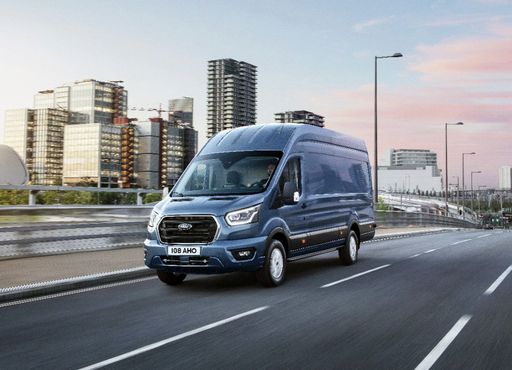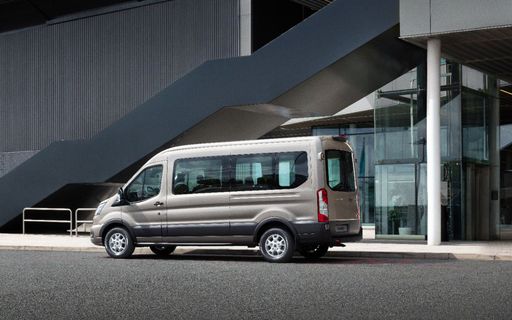Ford Transit Connect vs VW Crafter – Rendimiento, autonomía y consumo comparados
Compara de un vistazo rendimiento, maletero, consumo y precio.
Descubre ahora cuál es la mejor elección para ti – Ford Transit Connect o VW Crafter.
Ford Transit Connect vs. VW Crafter: A Cargo Van Showdown
In the world of cargo vans, the Ford Transit Connect and VW Crafter stand out as leaders, each offering a blend of practicality, performance, and innovation. As businesses continue to demand reliable and efficient solutions for transportation needs, these two contenders have carved their own niches. Let's dive into the technical aspects, innovations, and unique features of each vehicle to understand what they bring to the table in 2024.
Engine and Performance
The Ford Transit Connect is known for its versatility, offering both diesel and plug-in hybrid engine types. With power outputs ranging from 102 HP to 150 HP, the Transit Connect is designed to cater to different performance needs while offering the additional benefit of a plug-in hybrid option. Its engines come with a dual-clutch automatic or a manual transmission, ensuring drivers have control over their driving experience. The model offers a front-wheel-drive system, optimizing its road handling capabilities.
On the other hand, the VW Crafter delivers robust diesel power across its lineup. It offers a range of power outputs between 140 HP and 177 HP, with a variety of drive types including rear-wheel, front-wheel, and all-wheel drive. This flexibility makes the Crafter well-suited for a variety of terrains and purposes. Coupled with a manual or automatic gearbox, it ensures adaptability to driver preferences and road conditions.
Dimensions and Payload
For businesses focused on specific dimension needs, the Ford Transit Connect measures between 4500 mm and 4868 mm in length, a width of 1855 mm, and a height of up to 1860 mm. This compact size is especially beneficial for urban environments where maneuverability is key. The van provides seating for up to five passengers, making it versatile for both cargo and crew transport.
The VW Crafter, however, leans towards being the workhorse for larger jobs. With lengths stretching from 5986 mm to a significant 7391 mm, along with a payload capacity that can reach up to 2963 kg, it's designed to tackle demanding transportation tasks. Its body height varies significantly with a maximum of 2830 mm, allowing for various cargo configurations. This makes it an ideal choice for businesses requiring substantial cargo space.
Technology and Innovation
Both the Ford Transit Connect and VW Crafter are packed with features aimed at enhancing operational efficiency and driver experience. The Transit Connect capitalizes on its hybrid technology, offering a 19.7 kWh battery capacity which aids in reducing emissions and enhancing fuel efficiency for urban deliveries.
The VW Crafter features advanced diesel engines known for their durability and efficiency, with rolling efficiencies like a CO2 efficiency class G. It also excels in cargo space customization, enabling businesses to tailor the vehicle to specific needs, whether transporting delicate equipment or heavy goods.
Fuel Economy and Sustainability
Fuel efficiency is a critical consideration for any fleet manager. The Ford Transit Connect offers a competitive edge with its hybrid option, reducing reliance on diesel and improving overall fuel efficiency. This makes it a favorable option for businesses looking to minimize environmental impact while retaining performance.
The VW Crafter’s range of diesel engines offers average consumption figures between 8.4 L/100km and 12.6 L/100km, which is commendable for a vehicle of its size and capacity. Additionally, with larger fuel tank capacity, the Crafter is built for long-distance hauls without frequent refueling stops.
Conclusion: Choose According to Your Needs
Choosing between the Ford Transit Connect and VW Crafter primarily depends on your specific needs. If you’re looking for a balance of compact design, hybrid technology, and urban-friendly dimensions, the Ford Transit Connect is an excellent choice. In contrast, if your business demands greater cargo capacity, a variety of drive options, and the potential for robust customization, the VW Crafter stands as a versatile and reliable choice. Ultimately, both vehicles reflect the innovative strides made in the commercial vehicle sector, tailored to meet the diverse needs of today's logistical challenges.
Aquí vienen los hechos: las diferencias técnicas en detalle
Costes y consumo: El precio y la eficiencia son factores clave al comprar un coche – y aquí suelen notarse las diferencias reales.
Ford Transit Connect tiene una ventaja claro en precio: parte desde 33200 €, mientras que el VW Crafter cuesta 64100 €. La diferencia es de unos 30940 €.
También se aprecia una diferencia en el consumo: el Ford Transit Connect gasta 0.50 L y es convincente más eficiente que el VW Crafter, que consume 8.40 L. La diferencia es de unos 7.90 L cada 100 km.
Motor y rendimiento: Potencia, par motor y aceleración dicen mucho sobre la experiencia de conducción. Aquí se ve cuál ofrece más dinamismo.
En cuanto a potencia, el VW Crafter tiene una ventaja un tanto: 177 HP frente a 150 HP. Eso supone un aumento de unos 27 HP CV.
En velocidad máxima, el Ford Transit Connect es ligeramente superior – alcanza 186 km/h, mientras que el VW Crafter se queda en 165 km/h. La diferencia es de unos 21 km/h.
También hay diferencias en el par motor: el VW Crafter empuja ligeramente con 410 Nm frente a 350 Nm. La diferencia ronda los 60 Nm.
Espacio y practicidad: Habitabilidad, maletero y carga útil determinan la funcionalidad en el día a día. Aquí cuentan la comodidad y la flexibilidad.
Plazas: el Ford Transit Connect ofrece convincente más asientos – 5 frente a 2.
En peso en vacío, el Ford Transit Connect es fuerte más ligero – 1477 kg frente a 2072 kg. La diferencia ronda los 595 kg.
En capacidad máxima de carga, el VW Crafter es fuerte mejor – hasta 18400 L, unos 14700 L más que el Ford Transit Connect.
En capacidad de carga útil, el VW Crafter claro se impone – 2994 kg frente a 792 kg. La diferencia es de unos 2202 kg.
Nuestra conclusión: el Ford Transit Connect resulta ser supera al competidor en casi todos los aspectos y se convierte en nuestro ¡DriveDuel Champion!
En este comparativo, el Ford Transit Connect demuestra ser el modelo más completo.
Ford Transit Connect
El Transit Connect se destaca por su versatilidad y diseño práctico, convirtiéndolo en la opción ideal para profesionales y familias por igual. Su espacioso interior y diversas configuraciones permiten adaptarse a distintas necesidades de carga y transporte. Además, su eficiencia en combustible y maniobrabilidad en entornos urbanos lo hacen perfecto para la vida moderna.
detalles @ media.ford.com
@ media.ford.com
 @ media.ford.com
@ media.ford.com
 @ media.ford.com
@ media.ford.com
VW Crafter
El Volkswagen Crafter se destaca por su versatilidad y capacidad de adaptación a diferentes necesidades comerciales. Su diseño robusto y moderno lo convierte en una opción ideal para profesionales que buscan eficiencia y comodidad en el transporte de carga. Además, la amplia gama de configuraciones disponibles permite a los usuarios personalizarlo según sus requerimientos específicos.
detalles

|
|
|
|
|
Costos y consumo |
|
|---|---|
|
Precio
33200 - 49200 €
|
Precio
64100 - 93600 €
|
|
Consumo L/100km
0.5 - 5.8 L
|
Consumo L/100km
8.4 - 13.1 L
|
|
Consumo kWh/100km
-
|
Consumo kWh/100km
-
|
|
Autonomía eléctrica
118 km
|
Autonomía eléctrica
-
|
|
Capacidad de la batería
19.70 kWh
|
Capacidad de la batería
-
|
|
co2
11 - 153 g/km
|
co2
220 - 342 g/km
|
|
Capacidad del tanque
32 - 50 L
|
Capacidad del tanque
75 L
|
Dimensiones y carrocería |
|
|---|---|
|
Tipo de carrocería
Furgoneta de carga
|
Tipo de carrocería
Furgoneta de carga
|
|
Asientos
2 - 5
|
Asientos
2
|
|
Puertas
4
|
Puertas
4
|
|
Peso en vacío
1477 - 1866 kg
|
Peso en vacío
2072 - 2810 kg
|
|
Capacidad del maletero
-
|
Capacidad del maletero
-
|
|
Longitud
4500 - 4868 mm
|
Longitud
5986 - 7391 mm
|
|
Anchura
1855 mm
|
Anchura
2040 - 2069 mm
|
|
Altura
1856 - 1860 mm
|
Altura
2355 - 2830 mm
|
|
Capacidad máxima del maletero
2500 - 3700 L
|
Capacidad máxima del maletero
9300 - 18400 L
|
|
Capacidad de carga
602 - 792 kg
|
Capacidad de carga
1037 - 2994 kg
|
Motor y rendimiento |
|
|---|---|
|
Tipo de motor
Diésel, Híbrido enchufable
|
Tipo de motor
Diésel
|
|
Transmisión
Manuel, Automática
|
Transmisión
Manuel, Automática
|
|
Detalle de transmisión
Caja manual, Automático de doble embrague
|
Detalle de transmisión
Caja manual, Caja automática
|
|
Tipo de tracción
Tracción delantera, Tracción total
|
Tipo de tracción
Tracción trasera, Tracción delantera, Tracción total
|
|
Potencia HP
102 - 150 HP
|
Potencia HP
140 - 177 HP
|
|
Aceleración 0-100km/h
11.4 - 13.5 s
|
Aceleración 0-100km/h
-
|
|
Velocidad máxima
175 - 186 km/h
|
Velocidad máxima
90 - 165 km/h
|
|
Par motor
280 - 350 Nm
|
Par motor
360 - 410 Nm
|
|
Número de cilindros
4
|
Número de cilindros
4
|
|
Potencia kW
75 - 110 kW
|
Potencia kW
103 - 130 kW
|
|
Cilindrada
1498 - 1968 cm3
|
Cilindrada
1968 cm3
|
General |
|
|---|---|
|
Año del modelo
2024 - 2025
|
Año del modelo
2017 - 2023
|
|
Clase de eficiencia de CO2
E, B
|
Clase de eficiencia de CO2
G
|
|
Marca
Ford
|
Marca
VW
|
¿Qué tipos de tracción están disponibles para el Ford Transit Connect?
El Ford Transit Connect está disponible con tracción Tracción delantera o Tracción total.
Los precios y datos mostrados son estimaciones basadas en los precios de lista en Alemania y pueden variar según el país. Esta información no es legalmente vinculante.
